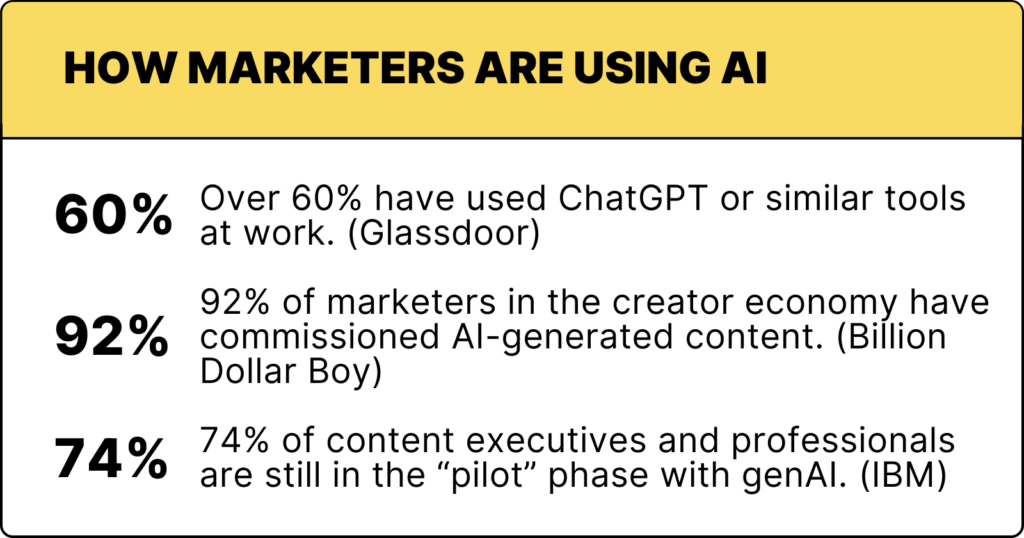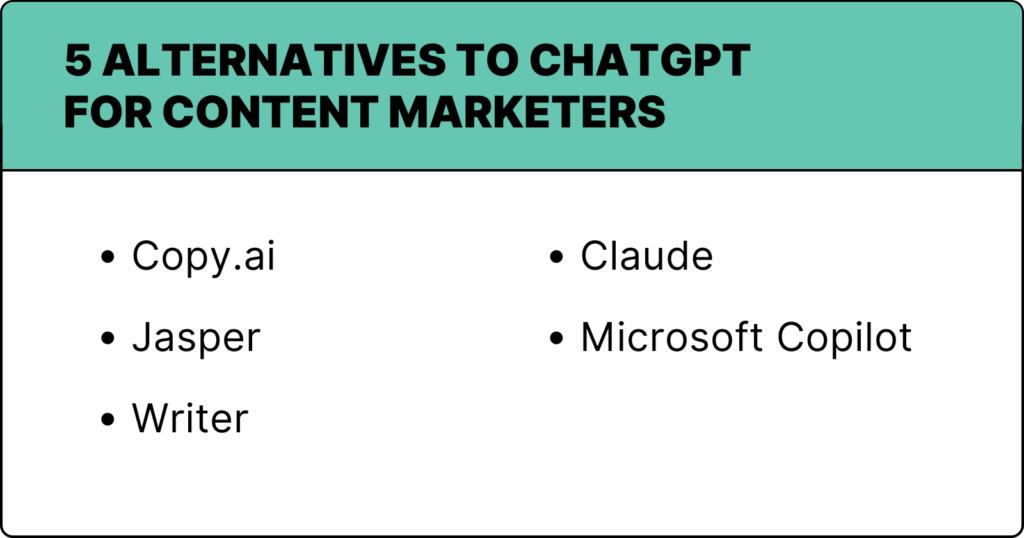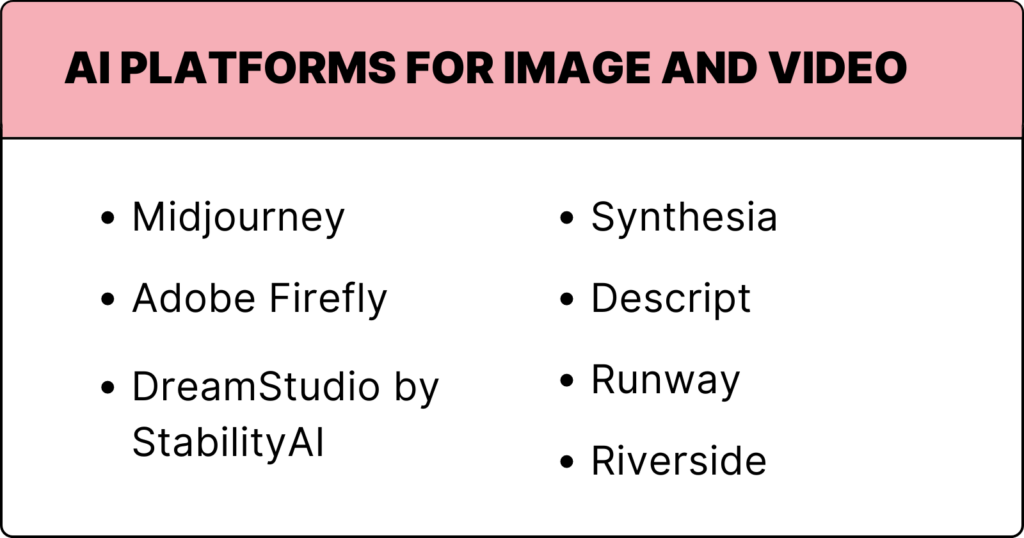Generative AI (genAI) has quickly moved from a futuristic dream to everyday life, with millions of people using ChatGPT for content marketing, communication, coding and countless other tasks. Employees aren’t waiting for permission or IT policies, choosing to experiment with AI out of curiosity, to maximize productivity or to future-proof themselves.
No industry has adopted genAI faster than marketing, with 77% using ChatGPT or similar tools in November 2023, according to Glassdoor. In the creator economy, adoption is near-universal, with 92% of marketers surveyed by Billion Dollar Boy having commissioned AI-generated content.
Content marketers aren’t avoiding ChatGPT or scratching their heads figuring out how to craft ChatGPT prompts. We’re learning to harness genAI’s full potential to transform how we create content, engage audiences and drive results. However, most of us are still exploring: 74% of executive and content professionals are in “pilot mode,” according to an IBM survey.
While ChatGPT was the first genAI tool for many content creators, it’s far from the only choice — especially if you need AI tools that are secure, trained primarily on your data and able to also handle audio and video, not just text. Learn more about alternatives to ChatGPT and the best AI content marketing tools on the market.

What Is ChatGPT?
ChatGPT, a large language model (LLM) developed by OpenAI, is at the forefront of generative AI and the most popular and widely used LLM to date. Many people are using ChatGPT for content marketing, and here are some of the reasons why.
Features and Benefits of ChatGPT-4
ChatGPT continues to evolve, with ChatGPT-4 acting as a one-stop shop for text and graphic creation. Features include:
- Multimodal capabilities: ChatGPT-4 is a multimodal model that can process text and images as input. In addition to text-based prompts, ChatGPT-4 integrates with another OpenAI product, DALL-E, to generate images based on text prompts.
- Expanded context window: Earlier versions of ChatGPT could handle 10,000 words of text, while the latest model can reportedly handle 25,000. That benefits long-form content creation, extended conversations and document search and analysis.
- Improved performance: ChatGPT-4 improves on previous versions in terms of understanding and generating human-like text. Its training data were updated to December 2023, include more nuanced instructions and can generate more creative and technical writing tasks.
- Training with human feedback: GPT-4 incorporates more human feedback, improving its behavior and making it more aligned with user intentions. This feedback includes submissions by ChatGPT users and consultations with over 50 experts in various domains.
- Safety and security: OpenAI has applied lessons from real-world use to improve GPT-4’s safety research and monitoring system. This includes producing more objective responses and being less likely to generate inappropriate content.
- Language capabilities: GPT-4 has improved its understanding and generating of text in different dialects, as well as responding to emotions expressed in text.
- Information synthesis: The model can synthesize information from different sources to answer complex questions, which is a step up from GPT-3.5.
- Problem-solving skills: GPT-4 can solve complex problems, including scientific and mathematical queries, surpassing its predecessor’s skill set.
- Cost-effectiveness and scalability: ChatGPT-4 is cost-effective and scalable compared to similar LLMs, allowing businesses to handle large volumes of queries simultaneously without investing in expensive human intervention.
- Personalization: The AI model can adapt to users’ queries and commands.
- Multilingual support: GPT-4 supports multiple languages, enabling its use in international operations or for customers who speak more than one language.
- GPT-4 Turbo: GPT-4 Turbo has a 128,000 context window, which can accommodate the equivalent of more than 300 pages of text in a single prompt.
- Custom GPTs: Of all the new features, Custom GPTs may be the most exciting. It allows users to tailor the chatbot to perform tasks related to image creation, writing, productivity and more. If you can create a prompt, you can build a Custom GPT.
Future Versions and Expectations
No one expects GPT-4 to be the last update from OpenAI, especially with competitors like Claude from Anthropic introducing new models as alternatives to ChatGPT. Here are some of the features under development by OpenAI or rumored:
- Sora, a much-hyped text-to-video AI model capable of generating realistic and imaginative video scenes from text descriptions.
- Vision technology that can analyze content from video and audio, as well as text and images.
- Regularly updated knowledge cut-off dates, making the model’s responses more current and accurate.
- Streamlined API workflows and more efficient apps.
Downsides of ChatGPT
ChatGPT is a pioneering technology that’s found many professional uses, including for content marketing. It even has tiers with different features (and pricing) for power users, teams and enterprises. However, there are downsides that limit its viability:
- While ChatGPT has tremendous resources at its disposal, including funding and integrations with Microsoft, the service remains a security and intellectual property risk in many ways. Employers must continue to be careful about unauthorized employee sharing of sensitive, confidential or proprietary information with ChatGPT (or any public-facing tool). In other cases, companies may be barred from using AI tools by contractual agreements or legal restrictions.
- ChatGPT can’t create novel ideas or perspectives on a topic. It can only rework and repurpose the information it’s trained on. The content it produces may be sensible and grammatically correct, but it lacks originality — a trait reserved for humans (for now).
- ChatGPT occasionally generates inaccurate or irrelevant information. Anyone using its output for business purposes would be wise to include a layer of human review and fact-checking. ChatGPT is prone to making up information that reads like it’s accurate — a phenomenon known as “hallucination.”
- Since ChatGPT generates content by pattern-matching and recombining parts of its training data, there’s a higher risk of plagiarized or unattributed outputs. This flaw is an additional legal risk for companies relying on AI-generated content marketing for text, image or video generation.
- ChatGPT lacks a nuanced understanding of specific brand tone and style, which is crucial for aligning with your content marketing style guide and brand guidelines.
- ChatGPT is designed to be a generalist AI, not an expert on particular topics. While it can discuss a wide range of subjects, the content it generates tends to be generic without the depth of insight or subject matter expertise that quality marketing content requires.
- Despite improvements, the model still struggles with non-standard or highly specific problems.
These pros and cons underscore the necessity of exploring alternative AI tools for content marketing, especially for teams that need to meet legal and compliance standards when using AI writing tools.

AI Content Marketing Tools That Aren’t ChatGPT
There’s no shortage of companies offering genAI tools for content creation. Here are some of the best alternatives to ChatGPT for content marketing, along with key features and pricing. Keep in mind that all of these platforms are rapidly evolving, and new entrants are likely to emerge.
Copy.ai
Copy.ai is one of several AI content marketing tools I use frequently. The platform describes itself as “a model-agnostic design offering you higher levels of flexibility and adaptability with access to GPT-4, Anthropic and Azure.” It can generate content tailored to specific prompts and brand voices.
Features
Copy.ai provides a streamlined dashboard with numerous prompt templates for creating blog posts, social media posts, email messages, product descriptions and more.
Three elements of the platform worth highlighting are the AI Marketing OS, Brand Voice and Infobase. Brand Voice lets you enter content that represents your brand, label it and apply that anytime you create content. You can have multiple brand voices, which works well for an agency or freelancer.
Infobase stores information about your company or brand that you can use to improve content generation quality. By contrast, most developers train AI models on public data. Think of Infobase as a knowledge base for your brand guidelines, value propositions and positioning documents. Create a hashtag to associate with the information, making it simple to input that info in your content.
AI Marketing OS makes workflows easy, whether you’re working on content briefs, SEO, demand generation or a variety of other tasks.
Limitations
It lacks long-form content capabilities and sometimes produces content that requires significant editing for accuracy and grammar.
Pricing
Copy.ai offers several plans, including a free version limited to 2,000 words per month. There’s also a “pro” plan for five users. It costs $36 per month and offers unlimited words. Copy.ai also offers a 20-seat “team” plan for $186 per month and an enterprise plan with custom pricing.
Recommended Use Cases for Content Marketing
Copy.ai is a great option for those looking for an AI-powered service that helps you create high-quality marketing copy quickly. Its workflows feature streamlines content creation, while the Brand Voice feature helps your team maintain the right tone
Copy.ai’s automated suggestion feature for topic and keyword research helps busy users and those with fewer resources. They can receive data-driven insights related specifically to their target audiences.
Jasper
Jasper, previously known as Jarvis, is an AI copywriting tool that makes content generation quick and efficient.
Features
Jasper, like Copy.ai, offers multiple languages, the ability to set brand voice and import company knowledge, and countless integrations. Jasper also offers Art, an image generator designed for royalty-free commercial use.
A powerful feature for brands or content agencies is its ability to create and manage integrated marketing campaigns. Meanwhile, Jasper keeps third-party AI models from training on your data, offers a built-in plagiarism checker, and optimizes your SEO content with a SurferSEO add-on.
Limitations
Despite its multilingual features, the tool may not adequately capture cultural nuances and context in its generated text. Also, Jasper doesn’t have a free plan, and its lowest-priced plan can be pricey for small teams or freelancers.
Pricing
Jasper has multiple paid plans, starting with $39 per month per user when paid annually for the Creator tier. The Pro plan is $59 per month per user when paid annually, but has additional features, including Jasper Art. Jasper’s enterprise plan has custom pricing and offers custom workflows, API access and more.
Recommended Use Cases for Content Marketing
For digital marketing, I recommend Jasper if you are looking for a comprehensive solution that provides automation across the content creation process — from idea generation through publication. Jasper is especially helpful if you need multi-language capabilities.
Writer
Writer is an AI-powered tool for content creation that helps marketers and businesses create high-quality content faster and more efficiently. The platform is designed to simplify content creation, from automated topic suggestions to copywriting assistance, editing tools and integration with third-party services. It’s an intriguing alternative to ChatGPT for content marketing teams inside enterprises, especially those in highly regulated industries.
Features
Writer offers several features tailored to content marketing, such as a distinct family of LLMs, natural language processing (NLP) and copywriting assistance tools.
The “Ask Writer” feature, combined with prompt templates, allows users to make nearly any type of content creation request. Ask Writer can handle up to 5,000 words of outside material, whether a URL, block of text or an uploaded document. Writer’s Snippets feature, meanwhile, allows your brand to save core messaging or content templates for easy reference across the team.
It has a full array of editing tools for polishing drafts before publishing, a thorough brand style guide and plagiarism detection. Additionally, it integrates seamlessly with external services such as Google Docs and Figma.
Writer was an early leader in being SOC 2 Type II- and HIPAA compliant, which indicates the company emphasizes ethical guidelines and the needs of heavily regulated industries.
Limitations
Writer relies mainly on pre-defined templates, although the “Ask Writer” tool is increasingly open-ended. Many features, such as customized templates, are only available for enterprise customers. Writer doesn’t offer pricing for individuals, as it’s positioned for larger teams and enterprises.
Pricing
Writer offers two pricing tiers: a team plan with up to five users at $18 per user per month and an enterprise plan with custom pricing and additional features. Both offer a 14-day free trial.
Recommended Use Cases for Content Marketing
Due to its extensive feature list, I recommend Writer to brand marketing teams looking for a comprehensive AI content creation tool, especially one that can automate so many types of content. However, it’s less well-suited to individual users who need customization for audience-specific needs. (Rep Cap, the publisher of Managing Editor, uses Writer.)
Claude
The latest version of Claude, known as Claude 3, is a family of state-of-the-art LLMs developed by Anthropic. The company tailors each model to work with different performance levels and use cases.
The Claude 3 models are:
- Opus. This is the most capable model in the Claude 3 family, designed for highly complex tasks.
- Sonnet. Positioned as the second-tier model, Sonnet is available to users without a Claude Pro subscription.
- Haiku. The fastest version and provide near-instant responses. Anthropic aims Haiku primarily at businesses and expects it to be the most cost-effective model, suitable for customer interactions, content moderation and optimizing logistics.
Features
Claude 3 features include multimodal abilities, an improvement on earlier versions. This makes them particularly useful for enterprise customers who work with PDFs, flowcharts and presentation slides. Claude 3 models exhibit human-like understanding, with the ability to handle more complicated queries with higher accuracy and enhanced contextual understanding.
Anthropic emphasizes the safety and reliability of its models, including their resistance to misuse. The company also offers copyright indemnity protections.
The latest Claude models are better performing, with Opus showing a twofold improvement in accuracy on open-ended questions compared to Claude 2.1. Its context window is 200,000 — considerably larger than ChatGPT — and can accept inputs of over 1 million tokens.
Like other leading genAI tools, Claude 3 has advanced vision capabilities and can process various visual components such as images, charts, graphs and technical diagrams.
In addition, Claude offers automated sentiment analysis, topic clustering, copywriting assistance tools and some editing capabilities. Use its API offerings to integrate with a variety of external services.
Limitations
Like older versions, Claude 3 still can’t see the internet, which means entering URLs will do you no good.
Pricing
Claude’s base offering is free to use. Claude Pro is a paid version that costs $20 per month in the U.S. and £18 monthly in the U.K.
Recommended Use Cases for Content Marketing
Claude’s interface is exceptionally streamlined. I find it one of the easiest to use. While not brand-specific, in my opinion, its output is often of a higher quality than ChatGPT. I find myself trending toward it more often for that reason.
I recommend Claude as a “utility player.” If you’re using ChatGPT for content marketing or another AI tool, consider adding Claude to your toolkit. Just remember its inability to see the web.
Microsoft Copilot
Microsoft Copilot is designed as an everyday AI assistant for consumer users and a powerful companion for business users in the Microsoft 365 suite. Marketing teams can use Copilot in a variety of ways, including through Microsoft Dynamics 365.
Features
Copilot integrates directly into Microsoft programs such as Word, Outlook and PowerPoint to help boost productivity. It excels at assisting with writing emails, reports, presentations and documentation. It is now the default AI for the Bing search engine and Microsoft Edge browser.
Limitations
Some users may be challenged to adapt to Copilot’s workflows and utilize all available features. Also, because the AI analyzes user data to function, it might raise privacy issues for some organizations and individuals.
Pricing
Copilot is free to use in Bing and Microsoft Edge , and Windows users will see versions of Copilot in a variety of other places. Copilot Pro is $20 per month, while Copilot with an annual Microsoft 365 subscription is $30 per month.
Recommendations for Use
Copilot is ideal for businesses that use Microsoft 365 applications extensively. Automating routine tasks and generating content can significantly enhance productivity across various departments. It also helps manage and document meetings efficiently, providing summaries and tracking action items, which is beneficial for managers and team leaders.
Search Engine-Based LLMs
Gemini
Gemini (formerly called Bard) is an LLM from Google that you can use for various tasks, including marketing. In some instances, I have found the responses it produces preferable to ChatGPT. Business users will want to look at the Google Workspace version of Gemini, which includes use cases for marketing teams.
Features
Gemini offers text and image generation capabilities while leveraging Google’s vast data and advanced AI technologies. It can create different text formats, such as poems, code, scripts, musical pieces, emails and letters. It can also engage in follow-up discussions, adjusting responses based on context.
Limitations
It may not be as customizable as other AI platforms. Also, like ChatGPT and other LLMs, Gemini can sometimes misinterpret information or provide inaccurate answers.
Pricing
Gemini is free for consumers, but you’ll need to contact Google about Workspace pricing.
Recommended Use Cases
It is ideal for users already embedded within the Google ecosystem, including those needing seamless integration with tools like Google Ads and Analytics.
Perplexity
Perplexity is an AI search engine that is an intriguing AI-powered alternative to Google because of its lack of ads, direct responses to queries and citation of all source information. In fact, the way it posits information may make some refer to Perplexity as an “answer” engine, not a search engine.
Features
Perplexity provides detailed, accurate answers and explanations across a wide range of topics. Its design assists with research, learning and complex query resolution.
Limitations
Perplexity is limited to text-based interactions and depends on the quality and range of input data for accuracy. Its interface may take getting used to. The free version offers a daily limit on searches and relies on less powerful AI models.
Pricing
Perplexity is free to use, albeit with usage limits. There is a Pro plan for $20 per month or $200 per year that offers unlimited search and file uploads.
Recommended Use Cases
It is a useful alternative to Google for search. I find myself using it more and more instead of Google, especially for in-depth research. (In fact, I used it extensively in writing this article.)

AI Image Creation Platforms
While many brands think of ChatGPT for content marketing as a text-based phenomenon, AI is showing up in every aspect of content production. In this section and the next, we’ll look at emerging AI marketing tools for images, video and audio.
Midjourney
Midjourney is an AI image generator that creates images from text prompts. It can produce a wide range of art styles, including photorealism, comics and surrealism.
Features
It allows for rapid experimentation with different styles and can inspire creativity. It works from a text prompt and offers four options per response.
Limitations
You access Midjourney via Discord, which may be a deal-breaker for some due to its more technical nature and less than user-friendly interface.. Also, you can’t edit prompt-generated images.
Pricing
Midjourney offers four pricing options:
- Basic: $10/month for limited generations.
- Standard: $30/month for more features and fast hours.
- Pro: $60/month for heavy users.
- Mega: $120/month, with even more monthly hours of fast GPU time.
Companies making at least $1 million per year must purchase the Pro or Mega plans.
Recommended Use Cases
It’s ideal for artists, designers and creatives seeking to explore new horizons and generate an almost infinite number of design options. It’s also useful for creating professional mockups, icons and photorealistic images.
Adobe Firefly
Adobe Firefly, part of Adobe’s Creative Suite, offers photo editing, text-to-image generation, text effects and more.
Features
Features include a user-friendly interface, ethical AI framework and seamless creative tool compatibility. You can create images from text prompts and generate fills, templates, vectors and text effects.
Limitations
Firefly is limited to generating stock images and text effects. It lacks imagination for specific prompts and limited composition controls.
Pricing
Firefly has multiple pricing options: a free plan with limited credits and a monthly premium plan for $4.99, along with single-app and Creative Cloud “all apps” plans.
Recommended Use Cases
Firefly is suitable for professionals who need to generate images, text effects and color palettes using simple text prompts. It’s by no means a replacement for Photoshop or other sophisticated graphics tools.
DreamStudio by Stability AI
DreamStudio is a generative AI text-to-image web application developed by Stability AI. It utilizes natural language processing to generate images from text prompts.
Features
The platform offers customizable AI image generation, which includes size, style and more tools. It offers a user-friendly interface and the ability to create up to 10 high-quality images at once.
Limitations
DreamStudio offers a variety of sizes, but the maximum square image is only 1024×1024 pixels, which may not be suitable for certain projects.
Pricing
DreamStudio pricing is approximately $1.18 for every 100 generation credits, but the cost depends on the settings chosen, such as the resolution and the number of steps used in the image creation process.
Recommended Use Cases
DreamStudio can help individuals and businesses. Recommended uses include experimenting with different artistic styles and creating images for education, marketing campaigns and branding.
AI Video and Audio Creation Platforms
Synthesia
Synthesia is a synthetic media generation company that specializes in creating AI-generated video content.
Features
Synthesia is particularly known for its use of AI avatars and text-to-speech technology to produce videos without the need for traditional equipment like cameras or microphones. It supports more than 120 languages, over 150 AI-based avatars and hundreds of narration voice styles. Synthesia also offers a video editing assistant, along with templates and royalty-free media types. Users can collaborate in shared workspaces, too.
Limitations.
It may not fully replace the authenticity of human performance in videos. Users can only produce a small amount of video on the two lower-priced plans, with a yearly cap that could sneak up on you quickly. Workspaces are only available on the highest-priced plan.
Pricing
Synthesia offers three plans, each billed annually but with a monthly payment:
- Starter plan: $22 per month. One editor seat with three guests.
- Creator plan: $67 per month. One editor seat with five guests and some additional features.
- Enterprise plan: Ask for pricing. Some features, including unlimited video minutes, are only available on this plan.
Recommended Use Cases
The platform is best for creating educational content, marketing videos and corporate training materials.
Descript
Descript offers video and audio creation and editing capabilities, including screencasts. One of Descript’s main use cases is marketing teams.
Features
Descript features automatic video transcript generation, along with direct editing to alter the video content. This doc-like editing environment can reduce the learning curve for less experienced video editors. Descript also offers AI tone of voice capabilities. Marketers can edit, collaborate and distribute video, including full-length YouTube videos and social clips, all from within the platform.
Limitations
Some users might still have a steep learning curve. If your team doesn’t need all of Descript’s capabilities, the platform could be overwhelming.
Pricing
Descript also offers various pricing plans to cater to different user needs.
- Free Plan. Descript’s most basic account includes one hour per month each of remote recording and transcription. Video export is limited to 720p, with 4K reserved for paid plans. AI features are limited.
- Creator Plan. This plan costs $12 per user per month when billed annually. It includes 10 hours each of transcription and remote recording per month, more extensive AI features, and 60 minutes of Descript’s “Studio Sound” feature instead of 10 minutes with the free plan.
- Pro Plan. The Pro Plan is available at $24 per editor per month with annual billing. Additional features include 30 hours each of transcription and remote recording per month, unlimited AI usage and additional filler-word removal.
- Enterprise Plan. Descript offers custom pricing for teams requiring enterprise-level features, including a dedicated account representative, single-sign-on (SSO) and security review.
Recommended Use Cases
Descript is useful for a wide range of video and podcast creation and editing applications, including for content marketing teams.
Runway
Runway offers a broad suite of video creation and editing tools that rely on AI capabilities, including text-to-video, text-to-image and image-to-image options.
Features
Runway offers more than 30 AI tools for a variety of use cases. Its Gen-2 platform allows users to generate videos from text prompts — both your own and based on the platform’s suggestions. The platform also supports the creation of short video clips, four to 16 seconds long.
Additional features include background removal, custom LUTs (Look-Up Tables for color grading), and real-time collaboration.
Limitations
You only have so much control over clip content, and it’s not designed for longer videos.
Pricing
Runway has numerous pricing options. For example, Gen-2 charges $.05 per second of generated video, but monthly plans come with credits. Tiers include:
- Basic Plan. This plan is free and includes 125 monthly credits for image generation. However, you can’t buy additional credits. Users are limited to three video projects, 720p video exports and 5 gigabytes of asset storage.
- Standard Plan. This plan is $12 per user per month for up to five seats. It offers 625 monthly credits, the ability to buy more credits, unlimited video projects, 4K exports and 100 GB of asset storage. Gen-1 videos can be 15 seconds long, up from 4 seconds on the free plan.
- Pro Plan. This plan costs $28 per user per month for up to 10 users and includes higher levels of credits and storage, among other features.
- Unlimited Plan. Priced at $76 per user per month, this plan offers unlimited video generation and all features from the Pro plan, plus 2,250 credits per month.
Recommended Use Cases
Runway is ideal for video artists, animators and designers looking to incorporate AI into their creative workflows.
Riverside
Riverside offers an all-in-one experience for video and podcast recording and editing, with tailored features for marketers as well as podcasters and audio producers. Riverside was early to 4K video and local recording, enabling the highest-possible video and audio quality for remote recording sessions.
Features
Riverside has many features seen in other video and audio platforms, as well as separate audio and video tracks per participant, automatic AI-generated transcriptions and a text-based editor. Producers can manage sessions in real time without them being recorded. Afterward, you can also use AI to create short clips from longer recordings.
Limitations
Prices can scale quickly for content marketing teams that extensively record video and audio. The user interface isn’t always intuitive when inviting people to be speakers rather than viewers, such as with live events.
Pricing
Riverside has a free plan with limited recording time and lower video quality. The company offers three paid plans:
- Standard plan: $15 per month for five hours of multi-track recording.
- Pro plan: $24 per month for 15 hours of recording. Additional features include “Magic Audio” sound adjustment and AI-generated transcriptions and show notes.
- Business plan: Custom pricing for unlimited multi-track recording and livestreaming, plus the producer role and additional production-based features.
Recommended Use Cases
Along with Descript, Riverside is ideal for content marketing teams looking to produce podcasts, webinars and similar high-quality events for businesses.
Explore Alternatives to ChatGPT for Content Marketing
AI in content marketing is a reality, and we need to learn how to use it effectively, efficiently and safely. Exploring all the different AI tools for content marketing will expand your knowledge, fill your toolbox and supplement your brand’s unique content strategy and in-house knowledge.
We’ve only discussed a handful of the alternatives to ChatGPT for content marketing. Undoubtedly, new genAI writing, editing and graphics tools will continue to emerge. Choose those that best align with your marketing strategy, and don’t feel you have to rely on a single solution. These tools are rapidly evolving, too, so don’t be afraid to try tools and switch as your needs — and their features — change.
Interested in more content marketing insights, including our Content Therapy column? Subscribe to our LinkedIn newsletter.






